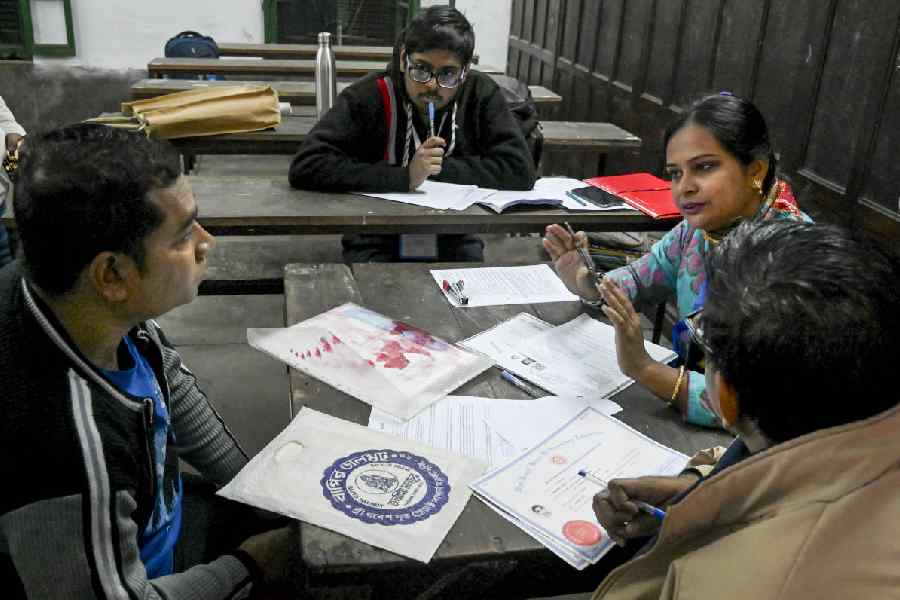Bhaswati Kamila Sarkar wakes up at 4 each morning. She cooks, finishes her domestic chores and bathes before leaving for her workplace. Her house in Satjelia in Bengal’s South 24-Parganas is on the other side of the Bidyadhari river. A 25-minute walk to the ghat and a three-minute boat ride later, Bhaswati reaches the Sajnekhali forest ranger’s office, her work address. Bhaswati is a tourist guide.
She and Bithika Roy were recruited by the West Bengal forest department in 2021. Recently, when Bhaswati, 35, was in Calcutta she spoke to The Telegraph about her new job, its challenges, what it takes and so on.
Bhaswati has done her bachelor’s; before this she used to do all kinds of odd jobs to earn a living. In Sajnekhali block, there are some 40 male guides and two female guides. Two more women had been selected but they dropped out after the two-month training. “Life inside the jungles is full of risks and uncertainties. It is not a matter of guts alone; understanding the ways of the forest is very important,” says Bhaswati. “The family also has to be supportive,” she adds. Her husband is also a tourist guide in the Sunderbans. He has been doing the job for the last 16 years.
Born in Dayapur in the Sunderbans, Bhaswati has known the jungle and its ways since she came into this world. She says, “But knowing the life of the jungle and being a guide are completely different things.” She continues, “I realised the day I returned from training. We got onto a boat with another senior guide and set sail for the jungles. We learnt the routes. It is no different from how city people know which road to take to get to office, which road to go someplace else. For us, it is the waterways. We have to know the creeks and canals, their names and which ones are the most difficult to negotiate.”
Every tourist who comes to the Sunderbans wants to see a tiger, but there is much more to the place. Says Bhaswati, “The flora and the fauna — there are 64 species of mangroves and another 20 varieties of plants which are to be found only beside mangrove trees.” She knows each one of them by name. “Sundari, Garan, Dewna, Bail, Passur, Kakra, Dhundhul, Khalsi, Hetal,” she rattles off the names.
What about the creeks? “The creeks and the canals of the Bidya-dhari are the soul of the Sunderbans,” she says.
Bidyadhari is a tidal river and it is imperative for a guide to be well acquainted with the nature of tides and their timings. “Or else you will get stuck,” she says. She goes on to narrate how once she got stuck with a boatful of tourists in a particular area for over two hours. All she could do was inform the forest department and wait.
Bhaswati is full of stories. She goes on, “This place is the meeting point of three islands and is also a path the tiger takes to move from one island to another. Once, I spotted a tiger crossing the river…”
Thirty minutes after sailing out from Sajnekhali, you pass the Su- dhanyakhali and Dobanki camps. These are within the sanctuary. Tourists can get down and roam around for a while. Some tourists get special permission to go into the core area, which is called Neti-dhopani Camp.
Bhaswati says she has taken tourists right up to the India-Bangladesh border’s buffer zone. Here there are three forest offices — Jhingekhali, Burir Dabri and Harikhali. Tourists stop at certain spots, get down from the boat and look around a bit. It is not always possible to rush them back to the boat, but linger on and the tide will change and one is sure to get stuck.
On completing training, Bhaswati had to go into the jungle all by herself. She says, “I am not afraid of the tiger. We have lived with them; I know I cannot fight a tiger. I will have to face it when I haveto face it.” But not all tourists seem to understand that the jungle has its rules and that wild animals must not be disturbed. She says, “They consume alcohol on the boat despite warnings that if they lose balance, they will fall into the waters. The waters are full of crocodiles and I will not be able to save them no matter how many life jackets I have on. There are places where they can drink, but not in the reserved areas.”
The boatman also has to listen to the guide or else she can report him to the forest department; one consequence can be the cancellation of the boatman’s licence.
“We have to be at work every day from 7am to 2pm and we get Rs 600 per trip,” says Bhaswati. On a single day, she can make a maximum of two trips. But this is not what she earns. She continues, “The money that comes from the trips is divided among all the guides present on that day in the Sajnekhali block. That way no one goes empty-handed.”











